Travel & Touring | WA Things To Do
22 April, 2019 By: Wendy Caccetta
In the enchanting marine kingdoms of our Coral Coast you’ll find close encounters of the oceanic kind.
So often the focus of a road trip is on the land. But imagine if you could do the Coral Coast trip under the water?
Western Australia’s Coral Coast stretches from Cervantes to Exmouth and includes the World Heritage listed Shark Bay Marine Park and Ningaloo Marine Park with its crystal blue waters.
Underwater is a veritable fantasy land of seagrass beds and coral reefs, home to mysterious whale sharks, friendly dolphins, humpback whales, dugongs and graceful manta rays.
It’s not surprising these watery paradises attract holidaymakers and scientists alike. Visiting is like living a David Attenborough nature documentary with something on offer all year round.
In the swim with whale sharks
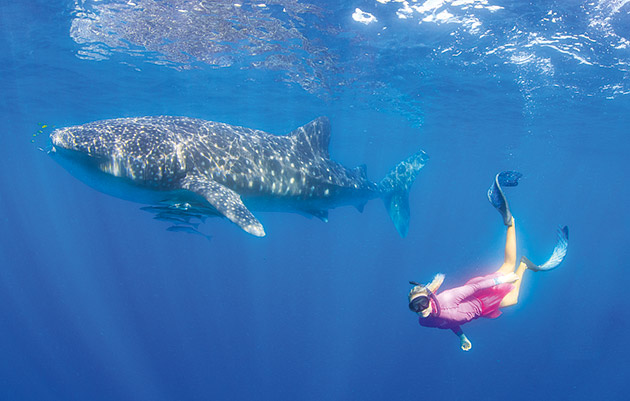
Last year a record 32,054 people travelled to Ningaloo to swim with whale sharks – the ocean’s gentle giants, in the only place in Australia where it is possible for such an encounter.
Whale sharks begin arriving in March and take up residence until about August when they again disappear to the ocean’s deep and a little understood other life.
“Whale sharks are quite mysterious, but they are also quite beautiful,” says WA scientist Brad Norman who has been studying them at Ningaloo for 24 years and is the lead scientist with conservation group Ecocean.
“They’re a shark and have a classic shark shape, but they’re a gentle shark. “
"You’re in awe when you swim alongside the biggest fish in the sea. I catch my breath every time I jump in the water and I’ve jumped in thousands of times with whale sharks.”
Whale sharks can grow up to 18 metres long, can live for up to 80 years and are good at keeping to themselves. Until the mid-1980s there had only been about 320 confirmed sightings of the animals globally.
Norman developed a photo identification system that is now used internationally, alongside satellite tracking and whale shark ‘fitbits’ to track the animals in the hope of unravelling their secrets.
“Whale sharks can dive down to thousands of metres and stay deep for months at a time,” says Norman. “They can travel thousands of kilometres, so they aren’t the easiest animal to study, but along the WA coast is certainly one of the best places in the world to study and swim with them.”
Licensed tour operators take small groups swimming with the whale sharks out of Coral Bay from March to late June and from Exmouth, March to August, with the season dependent on the comings and goings of the whale sharks.
Tours range from $280 to $550 per adult a day. Check for season dates with australiascoralcoast.com
Humpback heaven
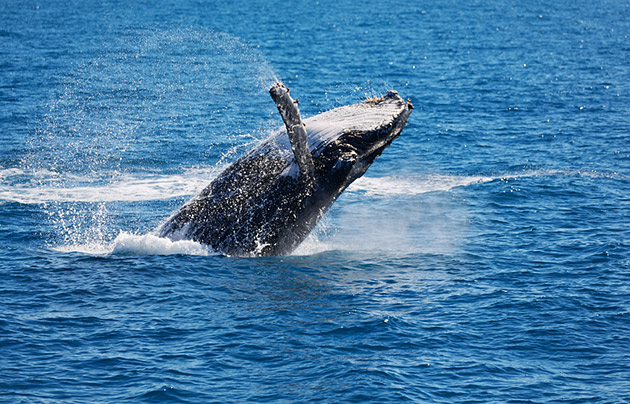
Scientists estimate at least 30,000 humpback whales — the highest density in the Southern Hemisphere — visit the Ningaloo Coast each year as they migrate between Antarctica and their feeding and breeding grounds along the WA coast up to the Kimberley.
Now you can get in the water and take a closer look at these majestic creatures yourself through licensed Ningaloo tours, with snorkelers allowed within 30 metres. WA is one of only a handful of places around the country and the world where you can do this.
The humpbacks also put on a spectacular show in Shark Bay, particularly around August to October as they head south.
“You won’t see them so much from Monkey Mia or Denham because the water is too shallow,” says Steve Nicholson, the Shark Bay district manager from the Department of Biodiversity Conservation and Attractions (DBCA). “You have to get further out in a boat around Dirk Hartog Island where the water is a bit deeper.
“They don’t seem to be in a rush. There’s lots of leaping out of the water. They’re not just swimming, they’re actively jumping out of the water and expending lots of energy.”
Licensed tours to swim with the whales run from July to September from Coral Bay and August to October from Exmouth, starting from $325 per adult, or watch from the boat for about $225.
Take a bath with a manta
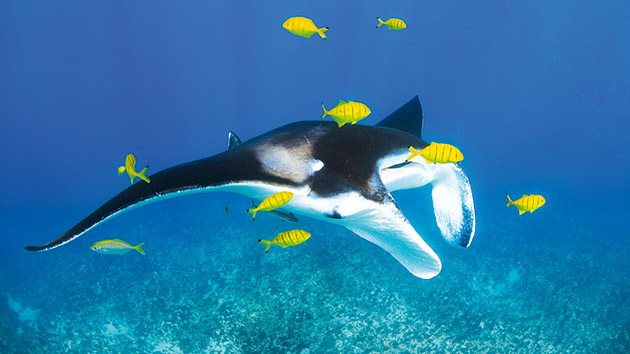
The ocean is full of surprises and watching a manta ray take a bath is right up there.
How? They rub up against the coral and use it like a loofah, says Suzanne Fisher from Australia’s Coral Coast (ACC).
“The manta rays are really extraordinary,” says Fisher. “The unique thing about them is although fish usually swim in a line, manta rays don’t. They often swim in circles so you’ll have them barrel roll and dance around you.”
At Ningaloo you can take a tour to swim alongside the mantas.
“The operators generally take you to the manta ray cleaning stations, so you’ll see them slowly cleaning themselves. Watching them feed, clean or dance around is really beautiful,” says Fisher.
Also look out for manta rays in the Shark Bay Marine Park. “There are often big congregations of them,” says DBCA’s Nicholson.
“At Herald Bight up on the eastern side of the Peron Peninsula you quite often see massive congregations of them or eagle rays - hundreds in one group. It’s spectacular.”
Tours run out of Coral Bay all year round and cost from $170 per adult for about six hours, half days for less, according to ACC.
Famous dolphins, elusive dugongs
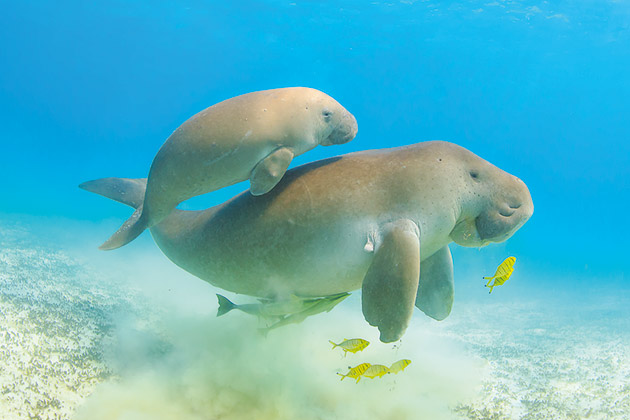
About 100,000 people a year visit Shark Bay Marine Park where bottlenose dolphins come into Monkey Mia each morning to be fed.
The tradition of feeding them, now called provisioning, began in the 1960s when fishermen began sharing their catch.
Steve Nicholson says the dolphins are handfed 10 per cent of their daily diet so they still must hunt. He says although only five of the Park’s thousands of dolphins are given fish, more visit daily.
“Sometimes you might get 10 or 15 dolphins,” says Nicholson. “Even the ones who aren’t fed still come in and I think it’s because they seem to like that interaction with human beings.”
Professor Janet Mann, of Georgetown University in Washington, is part of the Shark Bay Dolphin Project which has tracked nearly 1800 dolphins in the area from birth to death and contributed much of what is known about the social structure of bottlenose society.
Mann says the area’s dolphins are unique in the way they drive out fish from the sea floor and use sponges to protect their beaks when foraging for bottom-dwelling fish.
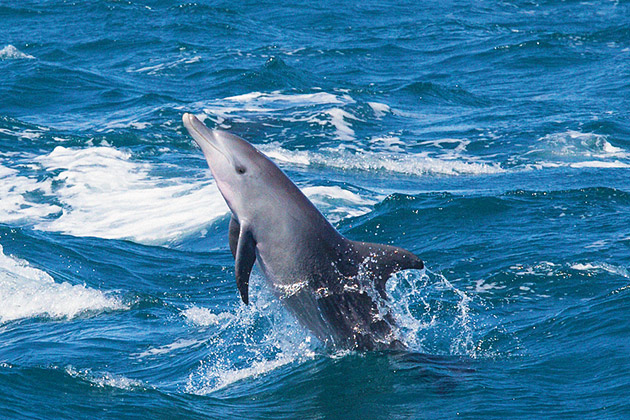
“Some of the provisioned dolphins will chase fish up and down the bay all day,” says Mann. “It’s fantastic for people to watch because they can literally stand on the beach and see dolphins chasing fish.
“But if you are in the water, stay still. People want to swim with them and they don’t realise these dolphins don’t really swim with you. If they are swimming along it’s because they are chasing something.”
Entry to Monkey Mia Marine Reserve is $15 per adult a day, $5 for children and there are family, concession rates and extended holiday rates available.
Shark Bay’s shyer residents, its population of 11,000 dugongs, or sea cows, like to graze along the ocean bottom in the seagrass beds that are special to the Shark Bay World Heritage area.
Nicholson says you may come across one by chance. “I go paddling out the front of Denham into the marine park and quite often see a dugong,” he says. “I’ve paddled off Monkey Mia, and the same thing there.”
The best option is to take one of the daily tours out to the where the dugongs loll about, diving down to eat and resurfacing to show their thick hides in the sun.
Tours out of Monkey Mia and Denham also look for dolphins, turtles and rays. They vary in price but cost about $100 for three hours for adults. Prime dugong time is August to October.
Save on Coral Coast stays
Members save up to 20%* at the four RAC Parks & Resorts along the Coral Coast: RAC Monkey Mia Dolphin Resort, RAC Exmouth Cape Holiday Park, Ningaloo Reef Resort and RAC Cervantes Holiday Park.
*Terms and conditions apply. Member rate varies according to season. See full website for details.
